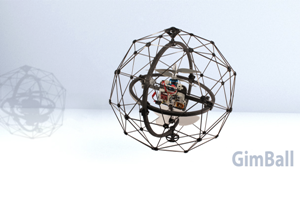Mar 18 2014
Gimball is a crash resilient flying robot stemming from work at NCCR Robotics lab, Laboratory of Intelligent Systems at EPFL, Switzerland and will be displayed and demonstrated by its designers at the NCCR Robotics stand at Innorobo.
 Gimball flying robot
Gimball flying robot
While much robotics research centres around collision avoidance, the team behind the Gimball decided to take the novel approach of developing a robot inspired by insects that would not avoid crashing, but would not be put off course or damaged during a collision.
The Gimball works using a unique double carbon-fiber ring which allows the core of the robot to remain upright. Two propellers are used for movement, while fins enable steering and an outer cage absorbs shocks and protects the inner mechanism. Not needing to avoid collisions means that the Gimball doesn’t require complex sensors, which can be heavy and easily damaged, thus making the robot lighter, more robust and easy to use in a wide range of situations.
With further work, the Gimball will be used in rescue operations, where a camera can be attached to the front allowing human teams to see what is inside a building which may be too dangerous to enter. Rescue operations tend to involve cluttered spaces often with limited fields of vision, so the development of a robot that can fly in unpredictable terrains unaffected by darkness, smoke or crashing is invaluable to on the ground rescue teams after disasters. Future work will involve development of a foldable structure for easy transportation.
The Gimball is winner of a Robotics spin fund, an NCCR Robotics initiative to aid creation of start up companies out of the NCCR Robotics, and has been selected as one of 25 finalists in the Hello Tomorrow Challenge.
About NCCR Robotics
The National Centre of Competence in Research (NCCR) Robotics is a nationwide centre, launched by the Swiss National Science Foundation, with the common objective of developing new, human-oriented robotic technology for improving our quality of life. The centre gathers leading robotics experts in Switzerland from cutting-edge research institutions: EPFL as leading house, ETH Zurich, University of Zurich and Dalle Molle Institute for Artificial Intelligence. Research follows three strands; rescue robotics, where robots are being developed to use swarming technology and multiple modes of locomotion; wearable robotics, where roboticists work with neurologists and materials science to develop unique prosthetics that can truly work with their wearer; and development of a new generation of foldable and reconfigurable robotic systems for teaching.